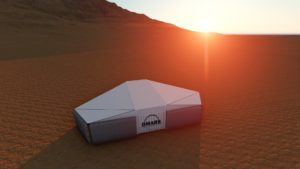
Astronauts to Simulate Life on the Red Planet in the Negev
Astronauts to Simulate Life on the Red Planet in the Negev
January 31, 2018
NoCamels – Six Israeli astronauts are getting ready to learn what life is like on Mars, without having to embark on a 300-day space voyage to get there.
A specialized structure, called Habitat, simulating the red planet’s unique environment is currently being built near Mitzpe Ramon in the heart of Israel’s Negev desert.
The space station housing astronauts, specifically trained for spaceflight and technical tests in simulated space environments, is the first one ever created in Israel.
This initiative called the D-MARS Project is headed by Dr. Hillel Rubinstein, a BGU postdoctoral student, under the guidance of Prof. Dan Blumberg, BGU’s vice president and dean for research and development and head of BGU’s Earth and Planetary Imaging Facility. It will promote science and technology research with a focus on space research.
The project “pulls Israel into the forefront of space, and particularly Mars, exploration,” says Dr. Rubinstein.
The astronauts will live in the analog research Habitat, inspired by the work of space agencies abroad, and set out on exploratory missions “on Mars” in spacesuits. They will go about their daily routine as if in space. The structure was built by the Faculty of Architecture at The Technion.
The Israeli communications satellite operator Spacecom partnered with D-MARS to provide its AMOS-7 satellite, which will serve as the communication link between the astronauts and an off-site controls and operations center.
“With the AMOS-7 satellite, we are adding an interplanetary-type communications facet to our experiments by simulating various challenges for our analog astronauts to handle and overcome,” says Dr. Rubinstein.
The “Ramonauts,” as they are dubbed by the project, will even conduct blackout periods, a planetary phenomenon, where Mars passes almost directly behind the sun from the perspective of the Earth, causing difficulties in radio communication.
The name Ramonauts is in memory of Israeli astronaut Ilan Ramon z”l whose space shuttle mission ended with a fatal re-entry accident 15 years ago.
The Mitzpe Ramon location was picked based on its similarity to Mars’s prevailing conditions – in terms of soil structure, geology, aridity, appearance, and isolation. The environment provides a combination of elements for space simulations that are difficult to find in other parts of the world.





